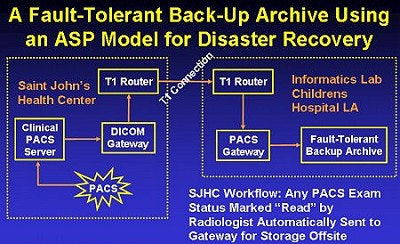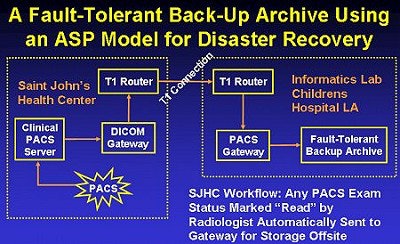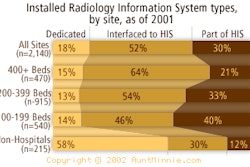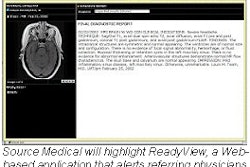
Planning for data recovery and backup is crucial in a filmless environment, because the only copy of the imaging study may be the one stored in the PACS archive. In addition, future requirements of the Health Insurance Portability and Accountability Act (HIPAA) may necessitate a disaster-recovery solution for PACS data, according to Brent Liu, Ph.D., a consultant and former PACS system administrator and director of special projects at Saint John's Health Center in Santa Monica, CA.
Liu, who also serves as PACS implementation manager at the University of California, Los Angeles Medical Center, spoke at the 2002 RSNA meeting in Chicago on his experiences with an application service provider (ASP) backup archive at Saint John's and Children's Hospital Los Angeles/University of Southern California.
"We all know it's clinically crucial to have previous PACS exams in order to read the current exam," he said. "And if anything happens to the onsite archive, the damages and costs are comparable to losing an entire film archive in the radiology department. Finally, as in any large-scale system, scheduled downtime (for the PACS) may be necessary for the main archive server, but radiologists still need access to historical studies."
General disaster-recovery/backup solutions might consist of creating a second copy of any new PACS exam, with data storage on media onsite or offsite, Liu said. A third copy could also be created via daily backup of PACS exams, which could also be stored onsite or offsite. Still, this step wouldn't necessarily be quick or easy.
"These solutions are sometimes costly and manually labor intensive," he said. "And they still can't provide a temporary backup solution for downtime events of the main archive server."
An ASP approach
Instead, institutions might benefit from deploying an offsite, backup server to store second copies of images, Liu said. The copy could be stored automatically, and there's no need for an operator to perform daily tasks with data media.
In addition, backup storage capability can be easily configured to meet required needs. During a disaster, there's a high likelihood the network will be down, requiring a portable solution as well, Liu said.
To fit this model, the 233-bed hospital and the Image Processing and Informatics Lab (IPI-Lab) at CHLA/USC set up a homegrown ASP-model offsite archive.

At Saint John's, the PACS archive server automatically creates a copy of the exam after it has been read by a radiologist and sent to an ASP DICOM gateway.
"The gateway is crucial," Liu said. "Since it has its own queue, it can buffer any transmission delays from the T1 connection without impacting the clinical PACS."
The exam is then directed across the T1 router to IPI-Lab at CHLA/USC, where a corresponding ASP DICOM gateway receives the PACS exam. The data is then forwarded into the backup archive, also located at CHLA/USC.
The backup archive is fault-tolerant with 99.999% availability, Liu said. Currently, Saint John's has stored 279 GB worth of images at the backup archive.
If the clinical PACS server goes down, a query/retrieve request can be made to the offsite archive, which can import the images directly into the PACS, Liu said. In the event of a disaster cutting off network access between Saint John's and the data center, the researchers have developed a portable data migrator.
Currently a laptop with plenty of disk space, the migrator is equipped with DICOM receive and send software, allowing PACS exams to be exported from the backup archive and imported directly into the clinical PACS.
"In the future, as more technology is available, we could use flash RAM or external hot-swappable hard disks to transfer the PACS data," he said.
Liu said that the ASP service offers an elegant and effective means of providing disaster recovery and backup functions.
"Backup procedures are automatic and easily configurable with no operator intervention," Liu said. "Quick recovery of previous PACS exams allows radiologists to continue to read with historical studies during the full recovery of the clinical PACS archive."
By Erik L. RidleyAuntMinnie.com staff writer
January 21, 2003
Related Reading
PACS firms integrate, broaden product lines, November 18, 2002
Privacy specialist offers a methodical approach to HIPAA compliance, August 30, 2002
HIPAA final privacy rule drives security implementation, June 7, 2002
Security planning can prevent PACS attacks, May 3, 2002
HIPAA to make challenging, costly demands on radiology, March 18, 2002
Copyright © 2003 AuntMinnie.com




















